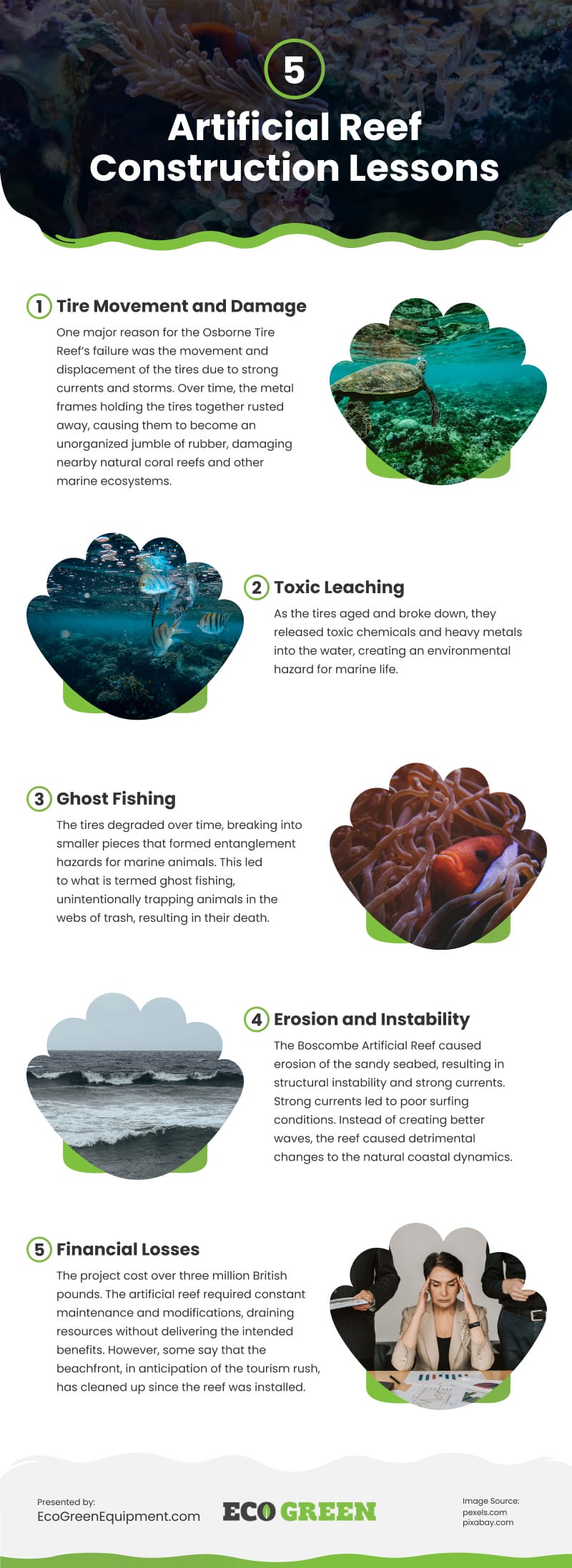
Innovation yields both benefits and drawbacks. While it enhances conveniences, it also presents risks, such as the ozone layer depletion from mid-1900s refrigerants. Similarly, in tire recycling, attempts like artificial reef construction have failed. This blog examines the successes and failures in tire recycling innovations, advocating for alternatives that are both environmentally friendly and profitable.
Recent Tire Recycling Innovation
Over the past five decades, tire recycling has seen remarkable advancements. Innovations such as tire-cutting machinery and the integration of tires into asphalt have notably mitigated tire pollution. Additionally, improvements in tire recycling plant operations, exemplified by technologies like the ECO Brain, which automates issue detection in production lines, have further enhanced efficiency.
The Good-Intentioned Idea of Artificial Reefs
The concept of artificial reefs isn’t inherently flawed. Shipwrecks and oil and gas platforms demonstrate how human structures can foster marine habitats, benefiting coral and fish populations. Scientists utilize artificial reefs for ecosystem studies, including the impacts of bottom trawling.
End-of-life tires’ bulkiness has prompted consideration for their use in artificial reefs, aiming to provide habitats for marine life. However, contrasting examples reveal potential drawbacks, suggesting alternative methods for repurposing tires more effectively.
Case Examples:
1.Osborne Tire Reef, Florida, USA
The ambitious Osborne Tire Reef project aimed to create an artificial reef off Fort Lauderdale, Florida, using about two million discarded tires. Originating in the 1970s, authorities anticipated it would enhance local fish populations and boost recreational diving and fishing.
Reasons for Failure:
Tire Movement and Damage:
The reef failed due to tire movement caused by strong currents and storms. Eventually, the metal frames deteriorated, resulting in disorganized tire arrangements that harmed natural coral reefs and marine ecosystems.
Toxic Leaching:
Aging tires released toxic chemicals and heavy metals into the water, posing an environmental threat to marine life.
Ghost Fishing:
Degrading tires created entanglement hazards for marine animals, leading to unintentional trapping and subsequent death, a phenomenon known as ghost fishing.
2. Boscombe Artificial Reef, United Kingdom
The Boscombe Artificial Reef, located off the coast of Bournemouth in the UK, aimed to enhance surfing conditions using tires and sand-filled geotextile bags to create an artificial reef. Local authorities believed it would attract more tourists to the area.
Reasons for Failure
Erosion and Instability:
The reef caused erosion of the sandy seabed, leading to structural instability and strong currents, ultimately resulting in poor surfing conditions.
Financial Losses:
Costing over three million British pounds, the project required constant maintenance, draining resources without delivering the intended benefits. However, some argue that the beachfront has improved since the reef installation, anticipating tourism growth.
What are Safer Alternatives for Tire Recycling?
Crumb Rubber for Sports Surfaces: Utilizing processed tire granules, or crumb rubber, offers a sustainable option for sports fields and playgrounds, providing cushioning and reducing injuries.
Rubberized Asphalt: Integrating crumb rubber into asphalt enhances road durability, decreases noise pollution, and improves traction, offering a practical use for discarded tires.
Tire-Derived Fuel (TDF): TDF serves as a substitute for coal in energy production, supporting the shift towards sustainable energy sources despite its atmospheric pollution. It plays a crucial role in transitioning away from fossil fuels.
source: https://ecogreenequipment.com/artificial-reefs-an-effective-way-to-recycle-tires/
Comments
Download this infographic.
